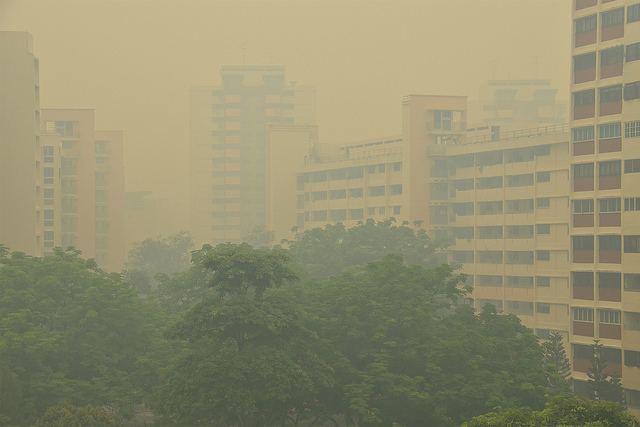Last week, an official from Indonesia’s national disaster agency warned that fires from Indonesia are likely to spread haze to Singapore and Malaysia yet again. A year ago in June, air pollution levels in Singapore reached record highs because of these fires.

Haze pollution at Singapore at 11:00 am on Friday, June 21st – around the same time pollution in Singapore hit a record high. Source: Choo Yut Shing/ Flickr
At that time, measurements of particulates and other pollutants such as carbon monoxide and ozone in the air soared to over 400 on a scale where anything over 300 is considered hazardous. While the 24-hour “average” measurements were a bit lower, peaking at 246 on June 20, air quality conditions were considered “very unhealthy” for 3 days and “unhealthy” for 5 days. The issue is so problematic that Singapore has set up an information website about the haze, giving updates about the haze and allowing citizens to easily track levels for themselves.
A perennial problem
While last June may have been the worst haze Singapore had seen yet, haze from outside its border is a common problem. Fires (mostly but not exclusively in Indonesia) burning vegetation and peatlands have become an annual event in the region, sending particulate matter and other pollutants into the air, often traveling across the Strait of Malacca into Singapore and Malaysia. As we reported last year, many of these fires could be traced back to oil palm plantations where fires are often deliberately set in order to clear land for plantings. This year, there is a 70% chance of El Niño developing this summer and an 80% chance this fall and winter. For Southeast Asia, El Niño mostly likely means a drier than average summer and thus would have an elevated risk of fire and subsequent haze.

Map of the fires causing air pollution in Southeast Asia in June 2013, initially prepared by Stu Sheppard using two days worth of data
Taking action
And so some in Singapore decided to take action. A proposed bill in Singapore, known as the “Transboundary Haze Pollution Act 2014,” would give Singapore the right to fine any entity (Singaporean or otherwise) whose activities outside of Singapore contribute to the haze problem. These actions would also constitute a criminal offense with fines up to 300,000 Singapore dollars (~ US $240,000) and even higher should an entity be found deliberately ignoring Singaporean authority’s request for action. Even further, anyone with evidence of personal injury, physical damage or economic loss could then sue these entities for damages in Singaporean court.
Should the bill pass, it remains to be seen just how effective it would be. Yet this bill shows just how serious Singapore is about doing everything in its power to hold entities accountable for the consequences of these fires. In fact, last Friday the Singaporean Ministry of the Environment and Water Resources released public feedback on the bill. While some comments raised concerns about the ability to enforce the bill, others expressed a desire for even higher fines, showing the engagement of Singapore’s citizens as well as its government.
The bill is expected to be discussed in early July and if it passes, will likely come into effect in October.
